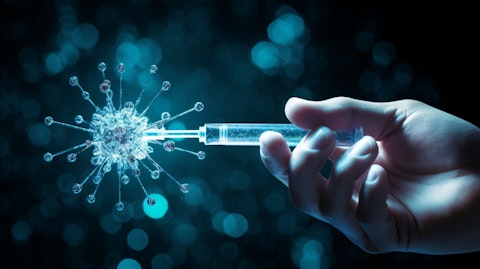Vaxart, Inc. (NASDAQ:VXRT) Q3 2025 Earnings Call Transcript November 13, 2025
Vaxart, Inc. beats earnings expectations. Reported EPS is $-0.04, expectations were $-0.07.
Operator: Greetings, and welcome to the Vaxart Business Update and Third Quarter 2025 Financial Results Conference Call. [Operator Instructions] As a reminder, this conference is being recorded. I would now like to turn the webcast over to your host, Ed Berg, Senior Vice President and General Counsel. Please go ahead.
Edward Berg: Good afternoon, and welcome to today’s call. Joining us from Vaxart are Steven Lo, Chief Executive Officer; Dr. Sean Tucker, Founder and Chief Scientific Officer; Dr. James Cummings, Chief Medical Officer; and Jeroen Grasman, Chief Financial Officer. Before we begin, I would like to remind everyone that during this conference call, Vaxart may make forward-looking statements, including statements about the company’s financial results, financial guidance, its future business strategies and operations and its product development and regulatory progress, including statements about its ongoing or planned clinical trials. Actual results could materially differ from those discussed in these forward-looking statements due to a number of important factors, including uncertainty inherent in the clinical development and regulatory process and other risks described in the Risk Factors section of Vaxart’s most recently filed annual report on Form 10-K and on other periodic reports filed with the SEC.
Vaxart undertakes no obligation to update any forward-looking statements after the date of this call. I’ll now turn the call over to Steven Lo. Steve?
Steven Lo: Thanks, Ed, and thanks to all of you for joining us this afternoon. I’ll begin today’s call with an overview of our business, then we’ll pass the call to James and Sean for the latest program developments. Jeroen will then share an update of our financials. And finally, I will have some closing comments before we open the call for your questions. Starting with our COVID-19 clinical program. Last week, we were excited to announce an important value-creating partnership with Dynavax, a commercial stage biopharmaceutical company that has a proven track record in commercializing innovative vaccines. As part of the agreement, Vaxart could potentially receive up to $700 million in total license, regulatory and milestone fees as well as royalties for our oral COVID-19 vaccine candidate.
This is a major milestone for the company and this program, which validates the potential of our platform and will provide critical nondilutive capital that will help us advance this program forward. Here are some of the important terms of the agreement. Dynavax will pay Vaxart an upfront license fee of $25 million and make a $5 million equity investment in Vaxart at a per share price premium to market pursuant to the terms of the securities purchase agreement. Combined with our current cash position, our cash runway now extends into the second quarter of 2027. Dynavax will receive an exclusive worldwide license to develop and commercialize oral COVID-19 vaccines based on Vaxart’s delivery platform. Vaxart will retain full operational and financial responsibility for the oral COVID-19 vaccine program through the completion of the ongoing Phase IIb clinical trial and the subsequent end of Phase II meeting with the FDA.
In addition, after receiving the results of the Phase IIb clinical trial, Dynavax will pay an additional fee of $50 million to Vaxart if Dynavax elects to assume responsibility for continued clinical development of the oral COVID-19 vaccine program. Finally, if Dynavax elects to assume responsibility for the continued development of the oral COVID-19 program, Vaxart may be entitled to receive up to $195 million in potential future regulatory milestone payments, up to $425 million in potential future net sales milestone payments and tiered royalties at rates in the low to mid-teens on potential future net sales of our oral COVID-19 vaccines. We believe this collaboration is extremely important for Vaxart as a company. It not only extends our cash runway, but it speaks to the potential of our oral vaccine platform, which could be a major differentiator versus other vaccine delivery methods.
Later on, James will highlight details of our Phase IIb progress, but we remain on track to announce multiple datasets in 2026. We appreciate Dynavax’s view that COVID-19 remains prevalent in society as infections, hospitalizations and even death persist and that the new solutions are in order. At the present time, there are very few deals in the vaccine space, and we appreciate Dynavax’s investment and expertise, which can assist in moving this project forward to approval. Partnering with Dynavax will also allow Vaxart to become better positioned for late-stage development on other indications. To reiterate, this is a major step forward for the company. We also appreciate that Dynavax shares our view that our innovative approach could potentially transform global public health and revolutionize distribution and administration.
We look forward to sharing updates on our progress and collaboration in the future. Turning to our norovirus program. As we previously shared, we were pleased to report positive Phase I top line results from our second-generation constructs, which demonstrated this vaccine technology produced much stronger antibody responses compared to our first-generation constructs. Since this positive top line data update, we have presented at multiple medical conferences, highlighting the statistically significant increases in GI.1 and GII.4 norovirus blocking antibodies as well as other analyses from the study, which underscores the potential for protection that the new constructs provide. Sean will share more details of our compelling norovirus data shortly.
Norovirus continues to be a leading cause of acute gastroenteritis worldwide, causing significant morbidity and mortality in countries of all income levels, particularly amongst young children and older adults. At an economic cost of more than $10 billion in the United States alone, there remains an urgent need for a safe and effective norovirus vaccine. We believe that our norovirus vaccine candidate has first-in-class or best-in-class potential as currently, there are no approved vaccines and other products in development do not have the unique profile as well as delivery advantages of our platform. We remain eager to advance this program and continue to dialogue with several interested parties since our last update. While we are committed to securing our partnership, please understand that these discussions are predicated on other parties’ time lines, not just ours.
As a result, we now anticipate initiating the next clinical trial in 2026, provided that we receive funding. To recap, with multiple programs, we look forward to further demonstrating the strength of our oral vaccine program. Now with a partner in Dynavax, we can further advance our COVID-19 program, pending 2 potentially robust data readouts in 2026. With a platform designed to generate both systemic and mucosal immunity, our oral pill vaccine has the potential to transform global public health and revolutionize distribution and administration. I’ll now turn the call over to Dr. Cummings for a review of our COVID-19 clinical program. James?

James Cummings: Thanks, Steve, and thanks to everyone joining today’s call. As Steve has discussed, we’ve made significant progress with our COVID-19 oral pill vaccine candidate on the business development front with the signing of an exclusive license agreement with Dynavax. We also continue to make important progress in the clinical development of this asset. As we announced in August, we did receive a stop work order from BARDA on our Phase IIb clinical study comparing our COVID-19 oral pill vaccine to a commercially available mRNA injectable vaccine. This order stopped enrollment, but allowed us to continue work associated with the per protocol follow-up of subjects who had already received a vaccine. In October, we announced that BARDA will continue to provide funding for follow-up for the approximately 5,400 enrolled subjects, consisting of 400 subjects in the sentinel cohort and approximately 5,000 subjects in the KP.2 cohort enrolled in the trial.
We believe that the trial data from the enrolled participants will provide useful insights and a strong foundation of evidence that could potentially advance our COVID program. As a reminder, the primary endpoint of this study is the relative efficacy of our oral pill vaccine compared with the mRNA vaccine for 12 months post vaccination. The trial will measure efficacy for symptomatic and asymptomatic disease, systemic and mucosal immune induction and adverse events in each cohort. We remain on track to report 12-month top line data from the 400-participant sentinel cohort in the first quarter of 2026 and to report 12-month top line data for all participants in the fourth quarter of 2026. In addition to potentially advancing our COVID-19 program, we believe the results of this trial also support our oral pill vaccine platform technology and inform development of our additional pipeline assets.
I’ll turn the call over to Dr. Sean Tucker for an update on those assets. Sean?
Sean Tucker: Thank you, James. In the third quarter, we presented additional Phase I data supporting the potential efficacy of our second-generation norovirus oral pill vaccine candidate at the Ninth International Calicivirus Conference. The data showed a 25-fold increase in the GII.4 fecal IgA response and a tenfold increase in the GI.1 fecal IgA response over baseline with a high dose of the second-generation vaccine candidates after a single tablet administration for each strain. The data also showed an eightfold increase in the GII.4 fecal IgA response and a sevenfold increase in the GI.1 fecal IgA response over baseline with a low dose of the second-generation vaccine candidates after a single tablet administration for each strain.
While the Phase I study was not powered to determine superiority by statistical methods, the fecal IgA increases observed with the second-generation constructs at the high dose compared favorably to the increases observed with the first-generation constructs at the same high dose level. As a reminder, results from the Phase II challenge study of our first-generation constructs identified fecal IgA as a critical correlate to protection from norovirus infection. The positive fecal IgA results observed with our second-generation construct, combined with the previously announced serum responses strongly suggests that the second-generation constructs induce much more robust immunological responses than our first-generation constructs. We believe this has the potential to translate into improved protection for our second-generation constructs.
As previously discussed, this program is ready to advance to the next clinical study pending a partnership or other funding. With the successful completion of our partnership with Dynavax for our COVID-19 program, norovirus remains a highly attractive opportunity, and we continue to focus on securing resources to advance our second-generation norovirus program. We are updating our guidance for the potential timing of the next clinical trial to start in 2026. I’ll now hand the call over to Jeroen for a brief discussion of our financials. Jeroen?
Jeroen Grasman: Thank you, Sean. The details of our third quarter 2025 financial results are summarized in today’s press release. Revenue for the third quarter of 2025 was $72.4 million compared to $6.4 million (sic) [ $4.9 million ] for the third quarter of 2024. Revenue in the third quarter of 2025 was primarily from the BARDA contract awarded in June 2024. Revenue in the third quarter of 2024 was primarily from a separate BARDA contract awarded in January of 2024. Vaxart ended the third quarter with cash, cash equivalents and investments of $28.8 million. Based on our current plan, which includes proceeds from our license agreement with Dynavax received after the quarter close, Vaxart expects cash runway into the second quarter of 2027.
Vaxart will continue to remain aggressive in seeking strategic partnerships, pursuing other nondilutive funding options and managing our expenses prudently in order to extend our cash runway. I will now turn the call back to Steve for closing remarks.
Steven Lo: Thank you, Jeroen. To recap, everyone here at Vaxart is excited about the collaboration agreement with Dynavax for our COVID-19 program. The support from Dynavax and their late-stage expertise will be instrumental as we advance this program. Moreover, this partnership further validates our oral vaccine platform, underscoring its potential in transforming global public health. We look forward to sharing multiple data readouts from our COVID Phase IIb trial in 2026. Our pipeline of norovirus, flu and HPV assets, which are backed by promising preclinical and clinical data demonstrate the broad value of our oral vaccine platform. We remain actively engaged with many interested parties about partnership opportunities for each of these programs, and we’ll share updates on developments as they become available.
Before we take your questions, I would like to remind our listeners that we have a scheduled webcasted fireside chat on Tuesday, November 18, at 4:30 p.m. Eastern Time. At the fireside chat, we look forward to addressing more of the frequently asked questions we have received from our stockholders. As a reminder, you can submit written questions to ir@vaxart.com. We will do our best to answer as many questions as possible at the fireside chat. Since we have the fireside chat next Tuesday, we will not take written questions on the call today. Thanks, everyone, for your time today. Operator, you may open up the line for questions.
Q&A Session
Follow Vaxart Inc. (NASDAQ:VXRT)
Follow Vaxart Inc. (NASDAQ:VXRT)
Receive real-time insider trading and news alerts
Operator: [Operator Instructions] Our first question is from Cheng Li with Oppenheimer.
Cheng Li: Congratulations on the progress and the collaboration with Dynavax. Maybe 2 questions from us. First, can you maybe talk about why Dynavax decided to reach a deal now instead of maybe waiting for a few months for — to see the data from the sentinel cohort in early ’26? And also like can you provide some color on the data they saw before maybe reaching the deal? And I have a follow-up question.
Steven Lo: Great. Cheng, thanks for the question. Yes. So first of all, we’re, of course, very excited to have our partnership with Dynavax. And in terms of just what they looked at, right, I think at the high level, first is the science in the platform. And I think there was a lot of discussions around what the platform can offer, right, and all the things we’ve talked about in terms of the oral delivery, the mucosal immunity, et cetera. And then on top of that, right, I think this was a good time for both companies even before the data came out because of the good fit between the companies, right? We’re really happy to have a proven vaccine company that has been able to take a product through FDA approval as well as through commercialization.
And I think it just worked out really well from a timing standpoint, and we’re delighted to have them on board. In terms of the data that they would have seen, and James can certainly comment on this, we’re blinded to the clinical data. But as well, in any partnership deal, there is quite a bit of due diligence. And so we’re actually pleased that they did take their time, go through the diligence and in the end, felt very comfortable with moving forward with the deal. James, if you want to just comment or reiterate on the fact that certainly in the clinical trial, we’re blinded, I’ll let you comment more on that.
James Cummings: Thanks, Steve. So from the clinical trial currently ongoing, we are — it’s a double-blinded trial. So both ourselves as well as the participants are unaware of which product they may have received, and we continue to collect data on them. The sentinel cohort will have top line data available in Q1 of 2026. The larger KP.2 cohort, which is approximately 5,000 individuals will have top line data available when that study is concluded during its 12-month follow-up, and that would put us in Q4 of 2026. Until that time, because we are double blinded, we can’t comment on further on the study over.
Cheng Li: Got it. That’s helpful. And I guess just another question is with the additional funding like upfront payments from Dynavax. Can you maybe talk about your thinking about the norovirus program, whether you can maybe start the Phase IIb trial by yourself? If not, what kind of the pipeline priority you are thinking with the additional funding?
Steven Lo: Yes. Thanks, Cheng, for the question. I think overall, we’re, number one, excited that we have the validation from a proven vaccine company that our technology has good utilization in the marketplace. And certainly for a COVID vaccine candidate, right, they share — Dynavax shares in our same view about this still being a good opportunity in the marketplace. In terms of our other assets, whether it’s HPV, norovirus, even flu, it’s created some opportunities for us to really have ongoing dialogue with potential partners on any of these assets. So the priority is still the same, which is including norovirus, being able to have productive conversations with anyone who is interested in partnering with us. On top of that, Sean, who’s sitting right here, I think he can also attest to the fact that with the validation of the platform, I think there’s also folks who may be interested in providing us their antigen to our platform.
Sean, if you want to comment more on that.
Sean Tucker: Sure. Yes. I think that given the strength of our clinical data and of course, with this recent validation by our friends across the bay at Dynavax, there’s been a lot of interest coming up about using some novel antigens with our system. And of course, these possible collaborations are still at a very early stage, but we remain committed on the current pipeline. But if something comes along, we’re very excited about moving it forward.
Operator: Our next question is from Roger Song with Jefferies.
Nabeel Nissar: This is Nabeel on for Roger. Just maybe a couple from us. How do you think about this year’s COVID season and — in comparison with last year and kind of the market potential for something that is again oral? And how do you also think about your product’s strain — ability to respond to strain change as we’ve seen also not just in COVID, but previously in norovirus?
Steven Lo: Great. Nabeel, thanks for the question. Yes, I’ll make some general comments about the market. And I think the best person to talk about strains and being able to respond to that is going to be James. But I’ll just make an additional comment just on our manufacturing. So I think the audience knows that we do our clinical manufacturing right here in South San Francisco. And for the COVID trial, we were pretty pleased to be able to produce not only just for the XBB strain but also for the KP.2 strain. So as a company, we think we were pretty versatile in being able to manufacture something for a strain in a very timely manner. I think you’ve seen as well, just to your first question around the COVID marketplace, right, and it’s still a sizable market.
Certainly, there are less folks who are taking the COVID shots now. It could be attributed to what’s happening in the press. It could be attributed to their perceived side effects. It could be just perceived on the fact that it’s a bit of a hassle to schedule an appointment, go to the pharmacy, get the shot. And from our standpoint, we offer a lot of advantages as well as alternatives to that. So I think from our standpoint, and Dynavax certainly evaluated as well that there is still a good market opportunity as it relates to COVID. I’ll turn it over to James. James, if you want to comment a bit just on strains and so forth.
James Cummings: Thanks, Steve, and thanks for the question. So I think 2 things. One, in terms of strain changes, what we’ve shown earlier in our development of this product is that we have the ability for cross-reactivity, not just for the strain of interest, the strain that was developed for this product, but also across newly developing strains. And so the benefit of this — one of the benefits of this protocol is that we’re looking at efficacy over an up to 12-month period. And during that time, not only taking a look at was someone ill or infected with the virus and/or symptomatically ill, but also taking a look at what the potential strains may be. As we know, the coronaviruses do have an ability to adapt and to shift or strain change.
And so we would expect over the course of a 12-month period that we’ll see more than likely one strain circulating certainly in the United States, but really across the globe. And — so that’s some of the data that we’ll be taking a look at as part of this study.
Sean Tucker: One other thing I — one other thing I’d like to add on, and this is one of the — again, one of the key things about that we demonstrated in a nice animal model is we showed that our vaccine in producing these mucosal responses, it could impact the ability of the virus to be transmitted to others. So it may have a better overall health benefit. And certainly, this kind of — this platform makes it, because it’s oral pill, much more differentiated than other things that are out there.
Operator: Thank you. This concludes our question-and-answer session. We want to thank you again for your participation today. You may disconnect your lines. This concludes our call.
Follow Vaxart Inc. (NASDAQ:VXRT)
Follow Vaxart Inc. (NASDAQ:VXRT)
Receive real-time insider trading and news alerts




